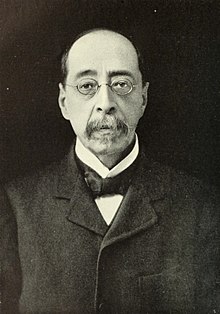John LaFarge
| John La Farge | |
|---|---|

John La Farge, 1902
|
|
| Born |
March 31, 1835 New York City |
| Died | November 14, 1910 (aged 75) Providence, Rhode Island, U.S. |
| Nationality | American |
| Education | Mount St. Mary's University |
| Known for | Painting, stained glass art, decorator, writer |
| Spouse(s) | Margaret Mason Perry |
John La Farge (March 31, 1835 – November 14, 1910) was an American painter, muralist, stained glass window maker, decorator, and writer.
La Farge was born in New York City to wealthy French parents and was raised bilingually; as a child, he and his brothers produced a handmade magazine in French entitled Le Chinois. His interest in art began during his studies at Mount St. Mary's University in Maryland and St. John's College (now Fordham University) in New York. He initially intended to study law, but this changed after his first visit to Paris, France in 1856. Stimulated by the arts in the city, he studied with Thomas Couture and became acquainted with notable literary people. La Farge also studied with the painter William Morris Hunt in Newport, Rhode Island.
La Farge's earliest drawings and landscapes, from his studies in Newport, show marked originality, especially in the handling of color values. Many of La Farge's mythological and religious paintings, including Virgil, were executed in an area of Rhode Island known as "Paradise," in a forest which La Farge called "The Sacred Grove" after Virgil.
He was a pioneer in the study of Japanese art, the influence of which is seen in his work. During his life, La Farge maintained a studio at 51 West 10th Street in Greenwich Village, which now is part of the site of Eugene Lang College at the New School University.
Between 1859 and 1870, he illustrated Tennyson's Enoch Arden and Robert Browning's Men and Women.
In the 1870s, La Farge began to do murals, which became popular for public buildings as well as churches. His first mural was done in Trinity Church, Boston, in 1873. Then followed his decorations in the Church of the Ascension (the large altarpiece) and St. Paul's Chapel, New York. For the Minnesota State Capitol at St. Paul, he executed at age 71 four great lunettes representing the history of law. He created a similar series based on the theme of Justice for the State Supreme Court building at Baltimore, Maryland. He also took private commission from wealthy patrons (e.g. Cornelius Vanderbilt) and was reputedly worth $150,000 at one point.
...
Wikipedia
